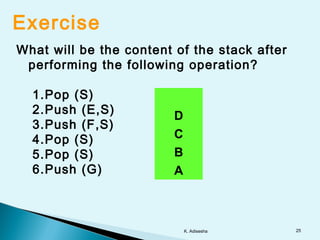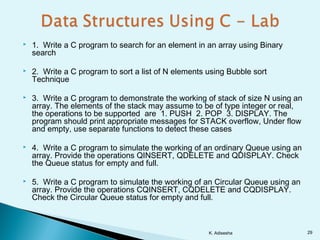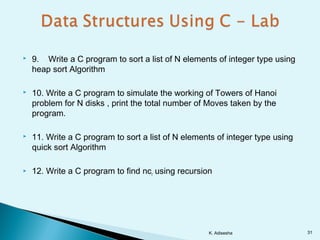Data structures using c
- 2. Objectives : • To understand how various data structures can be classified • To understand the most commonly used, basic data types and data arrays • To understand the characteristics and mechanisms of problem-oriented data structures used to solve specific problems, as well as how to use a basic data structure for program implementation 2K. Adisesha
- 3. Data It is an entity piece of information that is fact. Information Instruction + Data Data Structure It is a way of organizing data that considers not only the items stored but also the relationship of each data. 3K. Adisesha
- 4. Definition Primitive data structures Data structure which can be directly operated by machine level instruction Non primitive data structures Data structure which can not be directly operated by machine level instruction Linear data structure Non-Linear data structure 4K. Adisesha
- 5. Data Structure Problem-OrientedBasic Data Structure List Structure Stack Queue Basic Data TypeStructure Type Abstract Data Type Hash Tree Array Type Record Type Simple Type Pointer Type Integer Real Number Character Enumeration Partial Logical 5K. Adisesha
- 6. Dynamic memory allocation and pointers Recursion Searching and Sorting Stack Queue Linked list Tree 6K. Adisesha
- 7. Basic Data Type Simple Type Integer - represents whole number and is represented inside a computer as binary numbers of fixed-point numbers that have no significant digits below the decimal point. Real Number - represents fixed-point and floating point numbers. Character - represents fixed-point and floating point numbers. Logical - used to perform logical operations, such as AND, OR, and NOT operations. 7K. Adisesha
- 8. Structured Type Array Type One Dimensional Array One of the simplest and most common type of data structure. It is an ordered set consisting of a variable number of elements. The number of subscripts of an array determines its dimensionality. ArrayX [ j ] Array Name Element / Subscript / Index 8K. Adisesha
- 9. Structured Type Array Type One Dimensional Array Example: Grade [ j ] Grade [ 0 ] = 95 Grade [ 5 ] Grade [ 1 ] = 85 Grade [ 3 ] = 100 Grade [ 2 ] = 75 Grade [ 4 ] = 65 9K. Adisesha
- 10. Structured Type Array Type Two Dimensional Array An array with two subscripts. The first subscripts is called the “row”, and the second is called the “column”. int ArrayX [ j , k ] Array Name indexBase type 10K. Adisesha
- 11. Structured Type Array Type Two Dimensional Array Example: Grade [ 3 , 4 ] Grade C0 C1 C2 C3 R0 71 85 90 95 R1 97 88 78 87 R2 76 84 92 65 Grade [0,0] = 71 Grade [0,1] = 85 Grade [0,2] = 90 Grade [0,3] = 95 Grade [1,0] = 97 Grade [1,1] = 88 Grade [1,2] = 78 Grade [1,3] = 87 Grade [2,0] = 76 Grade [2,1] = 84 Grade [2,2] = 92 Grade [2,3] = 65 Row major 11K. Adisesha
- 12. Structured Type Array Type Two Dimensional Array Example: Grade [ 3 , 4 ] Grade C0 C1 C2 C3 R0 71 85 90 95 R1 97 88 78 87 R2 76 84 92 65 Grade [0,0] = 71 Grade [1,0] = 97 Grade [2,0] = 76 Grade [0,1] = 85 Grade [1,1] = 88 Grade [2,1] = 84 Grade [0,2] = 90 Grade [1,2] = 78 Grade [2,2] = 92 Grade [0,3] = 95 Grade [1,3] = 87 Grade [2,3] = 65 Column major 12K. Adisesha
- 13. Exercise An array has an index of x[3..8] and start at the address 245. It has 4 words per memory cell. What will the location of element x[5]? To get the location of elements To get the number of elements in an array Loc [k] = base + w (k-LB) NE = UB – LB + 1 13K. Adisesha
- 14. Memory Map 3 245 4 249 5 253 6 257 7 261 8 265 Element s Address Locate 14K. Adisesha
- 15. Exercise An automobile company uses array AUTO to record the number of automobile sold each year from 1932 to 1996. Locate AUTO[1980]. Assume 801 as starting address with 5 words long. Also find the length of the array AUTO. ANSWER: Loc[1980] = 1041 NE = 65 15K. Adisesha
- 16. Exercise Given a 4x5 array with [-3..0, 2..6) index, starting address is 81 with 2 words per memory cell. Locate [-1,5] using row major and column major representation. To get the location of elements (ROW MAJOR)Loc [j,k] = base + w [ N (j-LB1) + (k- LB2) ] To get the location of elements (COLUMN MAJOR Loc [j,k] = base + w [ M (k-LB2) + (j- LB1) ] To get the number of elements in an arrayM = UB1 – LB1 + 1 N = UB2 – LB2 + 1 NE = M x N 16K. Adisesha
- 17. Memory Map COLUM N Locate BAC 2 3 4 5 6 -3 81 83 85 87 89 -2 91 93 95 97 99 -1 10 1 103 105 107 109 0 11 1 113 115 117 119 R O W ROW MAJOR 17K. Adisesha
- 18. Memory Map COLUM N Locate BAC 2 3 4 5 6 -3 81 89 97 105 113 -2 83 91 99 107 115 -1 85 93 101 109 117 0 87 95 103 111 119 R O W COLUMN MAJOR 18K. Adisesha
- 19. Exercise When storing a two-dimensional array “a” with ten rows and ten columns in continuous memory space in the direction of rows, what is the address where a [5,6] is stored? In this question, the address is represented in decimal numbers. a [1,1] a [1,2] Addres s 100 101 102 103 a. 145 c. 190b. 185 e. 212d. 208 19K. Adisesha
- 20. Problem-Oriented Data Structure List Structure A linear collection of data elements called nodes and where linear order is given by means of pointers. DATA POINTER FIELD FIELD NODE AddressData 20K. Adisesha
- 21. Problem-Oriented Data Structure Types of List Structure Uni-directional List RAMOS 07H 03H AQUINO 03H 05H MARCOS 05H 01H HEAD ESTRADA NULL 07H TAIL 21K. Adisesha
- 22. Problem-Oriented Data Structure Types of List Structure Bi-directional List NULL MARCOS 05H 01H HEAD 01H AQUINO 03H 05H 05H RAMOS 07H 03H 03H ESTRADA NULL 07H TAIL 22K. Adisesha
- 23. Problem-Oriented Data Structure STACK An ordered list where all operations are restricted at one end of the list known as TOP. List processing is based on Last-In First-Out (LIFO). Bottom Top 23K. Adisesha
- 24. Problem-Oriented Data Structure STACK OPERATION PUSH - inserts a new element at the top of the stack POP - retrieves the element at the top and deletes it from stack. TOP - retrieves the element at the top of the stack 24K. Adisesha
- 25. Exercise What will be the content of the stack after performing the following operation? 1.Pop (S) 2.Push (E,S) 3.Push (F,S) 4.Pop (S) 5.Pop (S) 6.Push (G) D C B A 25K. Adisesha
- 26. Problem-Oriented Data Structure STACK APPLICATION INFIX - an expression where operator is placed in between the operands Example : (A + B) PREFIX - an expression where operator is placed before the operands Example : (+AB) POSTFIX - an expression where operator is placed after the operands Example : (AB+) 26K. Adisesha
- 27. Problem-Oriented Data Structure TREE Structure It is a collection of data items called nodes. Each node has a relationship with one or more nodes thereby giving a hierarchical structure. A CB D FE G IH J LK M Binary Tree / +* CB DA 27K. Adisesha
- 28. Exercise Create a Tree Structure based on the given prefix and postfix notation. 1.) - + / *A B G M * ^ N 3 - + G H ^ I 2 2.) F M 3 ^ * S / K * M 3 ^ L * - Q P 2 ^ * + 28K. Adisesha
- 29. 1. Write a C program to search for an element in an array using Binary search 2. Write a C program to sort a list of N elements using Bubble sort Technique 3. Write a C program to demonstrate the working of stack of size N using an array. The elements of the stack may assume to be of type integer or real, the operations to be supported are 1. PUSH 2. POP 3. DISPLAY. The program should print appropriate messages for STACK overflow, Under flow and empty, use separate functions to detect these cases 4. Write a C program to simulate the working of an ordinary Queue using an array. Provide the operations QINSERT, QDELETE and QDISPLAY. Check the Queue status for empty and full. 5. Write a C program to simulate the working of an Circular Queue using an array. Provide the operations CQINSERT, CQDELETE and CQDISPLAY. Check the Circular Queue status for empty and full. K. Adisesha 29
- 30. 6. Using dynamic variables and pointers Write a C program to construct a singly linked list consisting of the following information in each node; Roll - No (Integer), Name (Character string) The operations to be supported are ; 1. LINSERT Inserting a node in the front of the list 2. LDELETE Deleting the node based on Roll - No 3. LSEARCH Searching a node based on Roll-No 4. LDISPLAY Displaying all the nodes in the list 7. Write a C program to sort a list of N elements using Merge sort Algorithm 8. Using Dynamic variables and pointers construct Binary search tree of integers , Write C functions to do the following ; 1. Given a KEY, Perform a search in Binary search tree . If it is found display Key found else insert the key in the Binary search tree. 2. While constructing the Binary search tree do not add any duplicate 3. Display the tree using any of the traversal method K. Adisesha 30
- 31. 9. Write a C program to sort a list of N elements of integer type using heap sort Algorithm 10. Write a C program to simulate the working of Towers of Hanoi problem for N disks , print the total number of Moves taken by the program. 11. Write a C program to sort a list of N elements of integer type using quick sort Algorithm 12. Write a C program to find ncr using recursion K. Adisesha 31
- 32. Thank you K. Adisesha 32





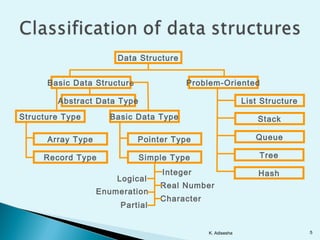
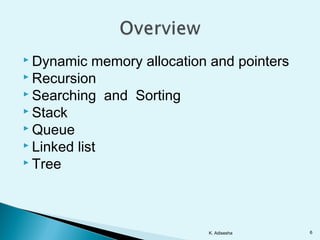

![Structured Type Array Type
One Dimensional Array
One of the simplest and most common type
of data structure. It is an ordered set consisting of a
variable number of elements.
The number of subscripts of an array
determines its dimensionality.
ArrayX [ j ]
Array Name
Element / Subscript / Index
8K. Adisesha](https://image.slidesharecdn.com/datastructuresusingc-160314163746/85/Data-structures-using-c-8-320.jpg)
![Structured Type Array Type
One Dimensional Array
Example:
Grade [ j ] Grade [ 0 ] = 95
Grade [ 5 ] Grade [ 1 ] = 85
Grade [ 3 ] = 100
Grade [ 2 ] = 75
Grade [ 4 ] = 65
9K. Adisesha](https://image.slidesharecdn.com/datastructuresusingc-160314163746/85/Data-structures-using-c-9-320.jpg)
![Structured Type Array Type
Two Dimensional Array
An array with two subscripts. The first
subscripts is called the “row”, and the second is
called the “column”.
int ArrayX [ j ,
k ]
Array Name
indexBase type
10K. Adisesha](https://image.slidesharecdn.com/datastructuresusingc-160314163746/85/Data-structures-using-c-10-320.jpg)
![Structured Type Array Type
Two Dimensional
Array
Example: Grade [ 3 ,
4 ]
Grade C0 C1 C2 C3
R0 71 85 90 95
R1 97 88 78 87
R2 76 84 92 65
Grade [0,0] = 71
Grade [0,1] = 85
Grade [0,2] = 90
Grade [0,3] = 95
Grade [1,0] = 97
Grade [1,1] = 88
Grade [1,2] = 78
Grade [1,3] = 87
Grade [2,0] = 76
Grade [2,1] = 84
Grade [2,2] = 92
Grade [2,3] = 65
Row
major
11K. Adisesha](https://image.slidesharecdn.com/datastructuresusingc-160314163746/85/Data-structures-using-c-11-320.jpg)
![Structured Type Array Type
Two Dimensional
Array
Example: Grade [ 3 ,
4 ]
Grade C0 C1 C2 C3
R0 71 85 90 95
R1 97 88 78 87
R2 76 84 92 65
Grade [0,0] = 71
Grade [1,0] = 97
Grade [2,0] = 76
Grade [0,1] = 85
Grade [1,1] = 88
Grade [2,1] = 84
Grade [0,2] = 90
Grade [1,2] = 78
Grade [2,2] = 92
Grade [0,3] = 95
Grade [1,3] = 87
Grade [2,3] = 65
Column major
12K. Adisesha](https://image.slidesharecdn.com/datastructuresusingc-160314163746/85/Data-structures-using-c-12-320.jpg)
![Exercise
An array has an index of x[3..8] and start at
the address 245. It has 4 words per memory cell.
What will the location of element x[5]?
To get the location of elements
To get the number of elements in an
array
Loc [k] = base + w (k-LB)
NE = UB – LB + 1
13K. Adisesha](https://image.slidesharecdn.com/datastructuresusingc-160314163746/85/Data-structures-using-c-13-320.jpg)

![Exercise
An automobile company uses array AUTO to
record the number of automobile sold each year
from 1932 to 1996. Locate AUTO[1980]. Assume
801 as starting address with 5 words long. Also find
the length of the array AUTO.
ANSWER:
Loc[1980] = 1041
NE = 65
15K. Adisesha](https://image.slidesharecdn.com/datastructuresusingc-160314163746/85/Data-structures-using-c-15-320.jpg)
![Exercise
Given a 4x5 array with [-3..0, 2..6) index,
starting address is 81 with 2 words per memory cell.
Locate [-1,5] using row major and column major
representation.
To get the location of elements (ROW
MAJOR)Loc [j,k] = base + w [ N (j-LB1) + (k-
LB2) ]
To get the location of elements (COLUMN MAJOR
Loc [j,k] = base + w [ M (k-LB2) + (j-
LB1) ]
To get the number of elements in an
arrayM = UB1 – LB1 + 1
N = UB2 – LB2 + 1
NE = M x N
16K. Adisesha](https://image.slidesharecdn.com/datastructuresusingc-160314163746/85/Data-structures-using-c-16-320.jpg)


![Exercise
When storing a two-dimensional array “a” with ten rows
and ten columns in continuous memory space in the direction
of rows, what is the address where a [5,6] is stored? In this
question, the address is represented in decimal numbers.
a [1,1]
a [1,2]
Addres
s
100
101
102
103
a. 145 c. 190b. 185 e. 212d. 208
19K. Adisesha](https://image.slidesharecdn.com/datastructuresusingc-160314163746/85/Data-structures-using-c-19-320.jpg)





